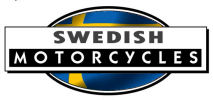





Rex-OEC Racing 2 Wheel Drive Combination

Rex-OEC 1935 1370cc JAP TWD
Source: europeeana.eu
CC BY-NC-ND 2.5
A comienzos del siglo XXI Yamaha presentaba su modelo WR enduro 2WD, sin embargo unos setenta años antes el ingeniero sueco Einar Stormark pensaba en la misma idea ya que sostenía que sobre terreno resbaladizo o para transmitir una alta potencia era mejor tener dos ruedas motrices.
En 1930 el piloto Berthold Ericsson corría en los campeonatos suecos con una motocicleta que había modificado caseramente, el cuadro y las ruedas eran de una OEC estándar que al principio tenía un motor JAP de 750 cc. pero con el fin de hacer una máquina ganadora le cambió el motor por un JAP 1000 cc. para luego llevarlo a 1370 cc. La fábrica sueca Rex se puso en contacto con Ericsson para ofrecerle asistencia y así fue que cambiaron el nombre de la moto a Rex.
Después de algunos años de competencia la fábrica contacta al ingeniero Einar Stormark que estaba experimentando con tracción en las dos ruedas y en el otoño de 1934 comenzaron las reformas de la moto. Stormark hizo los planos y los cálculos mientras Berthold Ericsson hizo los trabajos de soldadura y torneado. Con los 90 HP que entregaba el motor alimentado con metanol se podía utilizar una parte de esa potencia para trasmitirla a la rueda delantera y así disminuir el patinamiento de la trasera.
Stormark instaló por encima de la caja de cambios una segunda toma de fuerza desacoplable arrastrada por la cadena trasera que engranaba con tres piñones. Una cadena "delantera secundaria" transmitía la potencia a un cojinete situado debajo de la columna de dirección y equipada con un cardan. Una segunda cadena transmitía el movimiento a la rueda. El ingenioso truco consistía en reemplazar la tradicional horquilla paralelogramo por una horquilla telescópica "invertida". Así, con toda la transmisión fijada a los barrales de la horquilla y por lo tanto moviéndose con ellas como un basculante, las dos cadenas mantenían una tensión constante.
Para la primavera de 1935 la moto estaba lista y el 22 de abril disputa su primera competencia de “Hill Climb” (trepada de colina) en Malmsjö. Durante ese año disputa unas 10 trepadas, ganando en casi todas y también el campeonato sueco de sidecar. Al final de la temporada de 1935 la moto se desguaza aunque se conservaron las piezas más importantes lo que permite reconstruirla en 1960 y así es como hoy se puede ver exhibida en el Museo Técnico de Estocolmo.
1935 Rex (OEC – JAP) TWD
Motor JAP bicilíndrico en V OHV llevado a 1370 cc (86 x 117 mm), 90 HP a 5000 rpm
Dos carburadores Amal de doble cuba alimentados a metanol
Encendido por magneto Bosch
Caja de cambios separada, transmisión por cadena a la rueda trasera y desacoplable con dos cadenas y cardán a la rueda delantera
Cuadro de doble cuna
Suspensión delantera telescópica invertida, sin suspensión trasera.
In the 1930 Swedish Championships Berthold Ericsson ran a most unusual machine which had frame and wheels from a standard OEC powered by a JAP 750cc V-twin, later increased to 1000cc and then to a whopping 1370cc.
He established contact with the Swedish Rex concern who offered development assistance and as part of the deal the name of the machine was changed to Rex. The relationship progressed well, and Rex engineer Einar Stormark, who had been experimenting with 2WD, collaborated with Ericson to build such a machine. Stormark did the design and calculations whilst his Berthold did the machining and welding. The plan was to deliver part of the massive horsepower from the methanol engine (90hp in those days was truly remarkable) to the front wheel, reducing wheelspin and increasing overall traction. Work commenced in 1934.
Stormark installed on top of the gearbox a second power output which drove a chain to a cardan below the steering column, and power was delivered by a second chain down to the front wheel. Front suspension was altered considerably to cope with the drive train, and the solution was an "inverted telescopic fork" - or USD forks, as we now refer to them.
The motorcycle was ready for the spring of 1935, and on the 22th of April it was entered in its first competition, a hill climb in Malmsjö. During that year they contested about 10 hillclimbs, winning in almost all of them and also the Swedish Sidecar Championship. At the end of the 1935 season the bike was dismantled (possibly due to war clouds developing), with the most important parts being kept in safekeeping, allowing this quite remarkable machine to be rebuilt in 1960. It is on display on display at the technical museum in Stockholm. (http://www.tekniskamuseet.se)
1935 Rex (OEC-JAP) TWD
Sources: Sergio Scalerandi, Henshaw, et al.
He found out after trying this concept, that the next build would [have a driven sidecar wheel]. Although that was not with this really tuned JAP-Twin & is a different story...
Actually the bike was very hard to drive, so the [2 wheel drive] concept was not the success they had thought. The next race-bike was also 2-wheel driven but on both rears. The actual bike on the picture (at least has been) is on display at the Technocal Museum in Stockholm."
If you have information about these vintage Swedish motorcycles please contact us